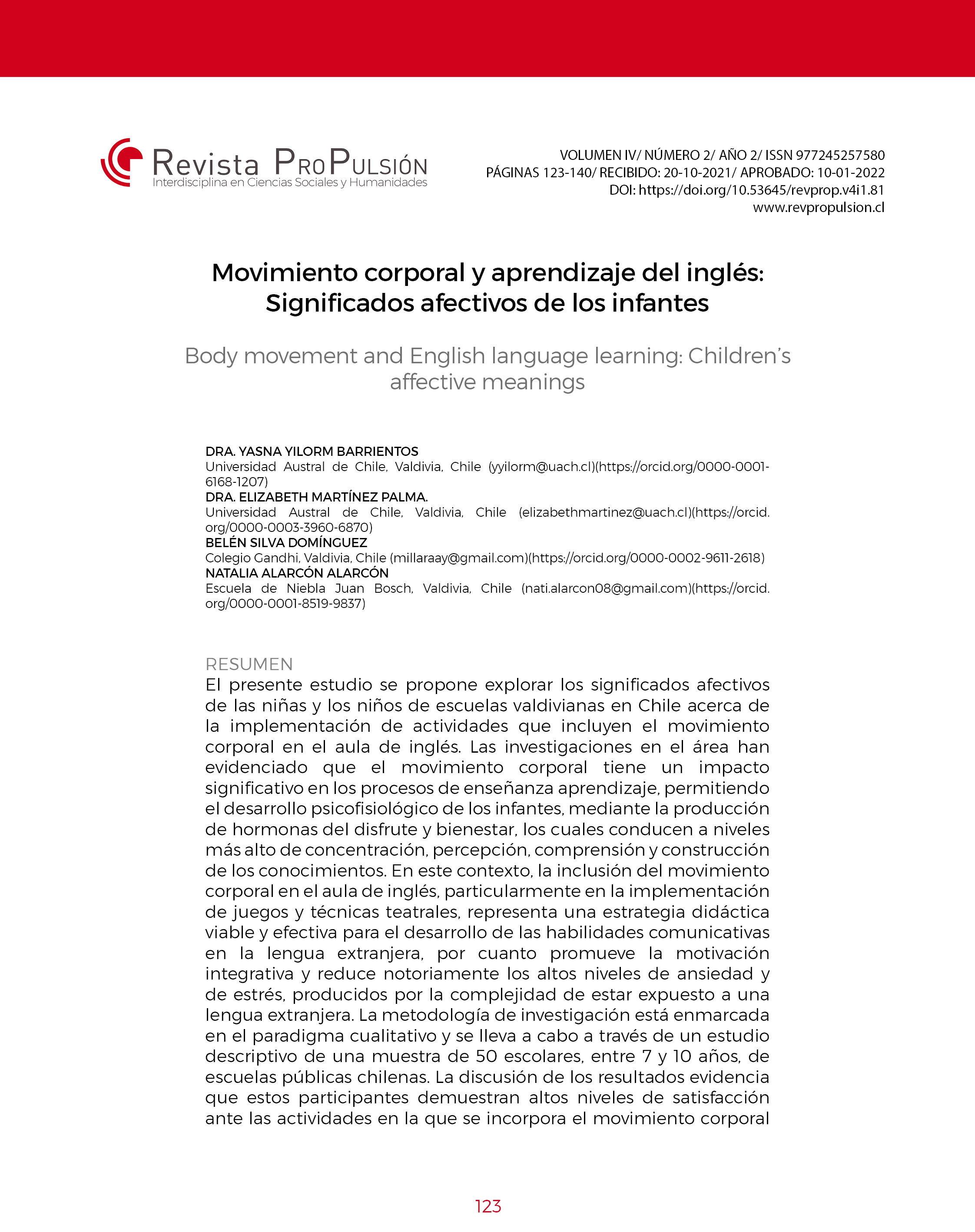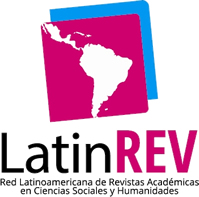Body movement and English language learning: Children’s affective meanings
DOI:
https://doi.org/10.53645/revprop.v4i1.81Keywords:
English learning, children, body movement, motivation, affective meaningsAbstract
This study purports to explore public school Chilean children’s affective meanings in relation to the implementation of body movement-based activities in English classrooms from Valdivia city. Research has shown that body movement has a meaningful impact on teaching learning processes. Children’s physio- psychological development is strengthened through enjoyment hormone production and wellbeing, which produces higher levels of concentration, perception, understanding and knowledge construction. The incorporation of body movement in the English classroom, particularly the implementation of games and drama techniques, stands for a viable and effective didactic strategy; integrative motivation increases and high levels of anxiety and stress, caused by the complexity of being exposed to a foreign language, are notoriously reduced. Therefore, communicative skills in the foreign language can be successfully developed. This research, which uses a qualitative research method, is carried out through a descriptive study, whose sample is composed of fifty 7 to 10-year- olds from Chilean public schools. The result discussion shows that participants are highly satisfied with activities that incorporate body movement for the English learning process and highlight the appropriation, understanding of new messages and production of words in a creative, friendly and amusing school environment.
Downloads
References
Alcedo, Y., y Chacón, C. (2011). El enfoque lúdico como estrategia metodológica para promover el aprendizaje del inglés en niños de educación primaria. SABER. Revista Multidisciplinaria del Consejo de Investigación de la Universidad de Oriente, 23(1),69-76. https://www.redalyc.org/articulo.oa?id=427739445011
Andreu, M., y García, M. (2000, November). Actividades lúdicas en la enseñanza de LFE: el juego didáctico. In Bordoy, M., van Hooft, A., &, Sequeros, A. (Ed). I congreso Internacional de español para fines específicos (pp. 121-125). Secretaría General Técnica.
Backes, B., Porta, M., y de Anglat, H. (2015). El movimiento corporal en la educación infantil y la adquisición de saberes. Educere, 19(64), 777-790. https://dialnet.unirioja.es/servlet/
articulo?codigo=6530221
Barreira, E. (2018). La enseñanza del inglés en el primer ciclo de la educación infantil como
práctica en escuelas y centros educativos. Propuesta de un modelo de actuación. RELAdEI. Revista Latinoamericana De Educación Infantil, 4(1), 211-243. https://revistas.usc.es/ index.php/reladei/article/view/4867
Bartholomew, J., Golaszewski, N., Jowers, E., Korinek, E., Roberts, G., Fall, A., y Vaughn, S. (2018). Active learning improves on-task behaviors in 4th grade children. Preventive medicine, 111, 49-54.
Benes, S., Finn, K., Sullivan, E., y Yan, Z. (2016). Teachers’ perceptions of using movement in the classroom. The Physical Educator, 73(1), 110-135. 10.18666/TPE-2016-V73-I1-5316
Braun, V., y Clarke, V. (2006) Using thematic analysis in psychology, Qualitative research in psychology, (3)2, 77-101. http://dx.doi.org/10.1191/1478088706qp063oa
Cabrera-Solano, P., Quinonez-Beltran, A., Gonzalez-Torres, P., Ochoa-Cueva, C., y Castillo- Cuesta, L. (2020). Enhancing EFL students’ active learning by using ‘formative’ on mobile devices. International Journal of Emerging Technologies in Learning (iJET), 15(13), 252- 263. https://www.learntechlib.org/p/217604/.
Cañas, L., y Chacón, C. (2015). Aportes de la neurociencia para el desarrollo de estrategias de enseñanza del inglés. Acción Pedagógica, (24), 52-61. https://dialnet.unirioja.es/servlet/ articulo?codigo=6224811
Caspersen, Powell, y Christenson, 1985. Physical activity, exercise, and physical fitness: definitions and distinctions for health-related research. Public Health Rep, 100(2), 126- 131.
Céspedes, A. (2002). Consideraciones generales para la integración en la escuela común de niños con dificultades afectivo-conductuales en G. Lucchini (Ed.), Niños con necesidades educativas especiales. Ediciones Universidad Católica de Chile.
Chamorro, I. L. (2010). El juego en la educación infantil y primaria. Autodidacta, 1(3), 19-37. Chee Hong, Y., y Ganapathy, M. (2017). To investigate ESL students' instrumental and integrative motivation towards English language learning in a Chinese school in Penang:
Case study. English Language Teaching 10(9), 17-35. 10.5539/elt.v10n9p1
Cohen, D., y Crabtree, B. (2006). Qualitative research guidelines project. Robert Wood
Johnson Foundation.
Creswell, J., Creswell, D. (2018). Research design: qualitative, quantitative, and mixed methods
approaches. SAGE.
Curtain, H., y Dahlberg, C. (2010). Languages and Children: Making the match, new languages
for young learners, grades K-8. Pearson.
Dörnyei, Z. (2019). From integrative motivation to directed motivational currents: The
evolution of the understanding of L2 motivation over three decades. In M. Lamb, K. Csizér, A. Henry & S. Ryan (Eds.), Palgrave Macmillan handbook of motivation for language learning (pp. 39-69). Palgrave.
Dinkel, D., Schaffer, C., Snyder, K., & Lee, J. M. (2017). They just need to move: Teachers' perception of classroom physical activity breaks. Teaching and Teacher Education, 63, 186-195.
Erickson, K., Hillman, C., y Kramer, A. (2015). Physical activity, brain, and cognition. Current Opinion in Behavioral Sciences, 4, 27-32. http://dx.doi.org/10.1016/j.cobeha.2015.01.005 Erlauer, L. (2003). The brain-compatible classroom: using what we know about learning toimprove teaching. ASCD.
García, C. (2016). Principios del aprendizaje del cerebro y su repercusión en el proceso de
adquisición-enseñanza de la lengua extranjera en la educación bilingüe. Encuentro:
revista de investigación e innovación en la clase de idiomas, 25, 76-86.
Gardner, R., y Lambert, W. (1972). Attitudes and motivation in second language learning.
Newbury House Publishers.
Gholami, R., Allahyar, N., y Rafik-Galea, S. (2012). Integrative motivation as an essential
determinant of achievement: A case of EFL high school students. World Applied Sciences
Journal 17(11), 1416-1424
Grieco, L., Jowers, M., Errisuriz, L., y Bartholomew, J. (2016). Physically active vs. sedentary
academic lessons: A dose response study for elementary student time on task. Preventive
Medicine, 89, 98-103. 10.1016/j.ypmed.2016.05.021
Gray, P. (2011). The decline of play and the rise of psychopathology in children and
adolescents. American Journal of Play, 3(4), 443-463. https://www.researchgate.net/ publication/265449180_The_Decline_of_Play_and_the_Rise_of_Psychopathology_in_ Children_and_Adolescents
Helgeson, J. (2011). 4 Simple Ways to Add Movement in Daily Lessons. Kappa Delta Pi Record, 47(2), 80-84.
Hernandez, T. (2006). Integrative motivation as a predictor of success in the intermediate foreign language classroom intermediate foreign language classroom. Foreign Language Annals, 39(4). ttps://doi.org/10.1111/j.1944-9720.2006.tb02279.x
Hyun, S., y Won , H. (2021). Second language learners' self efficacy and English achievement: the meditating role of integrative motivation. English Teaching & Learning 45(4), 1-14. 10.1007/s42321-021-00083-5
Jensen, E. (2010). Cerebro y Aprendizaje. Competencias e implicancias educativas. Narcea Krashen, S. (2012). The Compelling (not just interesting) Input Hypothesis. The English
Connection. KOTESOL, 15(3). 1.
Liu, M. (2006). Anxiety in Chinese EFL students at different proficiency levels. System, 34,
-316
Martin, R., y Murtagh, E. (2017). Teachers’ and students’ perspectives of participating in the
‘Active Classrooms’ movement integration programme. Teaching and Teacher Education,
, 218-230. 10.1016/j.tate.2017.01.002
McGregor, L., Tate, M., & Robinson, K. (1977). Learning through drama. Heinemann
Educational Books Ltd.
Merriam, S., y Tisdell, E. (2016). Qualitative research: A guide to design and implementation
(4th ed.). Jossey Bass.
Mieles, M., Tonon, G., y Alvarado, S. Investigación cualitativa: el análisis temático para el
tratamiento de la información desde el enfoque de la fenomenología social. Universitas
Humanística 74, 195-225. http://www.redalyc.org/articulo.oa?id=79125420009
MINEDUC (2022a). Inglés. Currículum Nacional. https://www.curriculumnacional.cl/portal/
Educacion-General/Ingles/
MINEDUC (2022b). Organización curricular Inglés. Curriculum Nacional. https://www.
curriculumnacional.cl/portal/Educacion-General/Ingles/20954:Organizacion-curricular-
Ingles
Mulatu, M., y Bezabih, W. (2018). The Effects of Teachers’ Perceptions on the implementations
of active learning in EFL classrooms. Global Journal of Human-Social Science Research, 18(6), 31-37.
Ray, B., y Seely, C. (2008). Fluency through TPR storytelling: Achieving real language acquisition
in school. Blaine Ray Workshops.
Reilly, E., Buskist, C., & Gross, M. K. (2012). Movement in the classroom: boosting brain power,
fighting obesity. Kappa Delta Pi Record, 48(2), 62-66.
Richard-Amato, P. (2009). Making it Happen. Pearson ESL.
Rodrigo, M. (2014). Desarrollo intelectual y procesos cognitivos entre los 2 y los 6 años en J.
Palacios, A. Marchesi, y C. Coll (Eds.), Desarrollo psicológico y educación. Alianza. Rozmatovna, A.O. (2020). The influence of integrative motivation and instrumental motivation on learning English as a foreign Language. Journal of critical reviews (7)2. 10.31838/
jcr.07.12.164
Shoval, E., Sharir, T., Arnon, M., y Tenenbaum, G. (2018). The effect of integrating movement
into the learning environment of kindergarten children on their academic achievements.
Early Childhood Education Journal, 46(3), 355-364. 10.1007/s10643-017-0870-x Stakanova, E., y Tolstikhina, E. (2014). Different approaches to teaching English as a foreign language to young learners. Procedia-Social and Behavioral Sciences, 146, 456-460.
https://doi.org/10.1016/j.sbspro.2014.08.154
Suciati, S. (2020). Speaking anxiety in EFL classroom: categories and factors. Edulingua: Jurnal
Linguistiks Terapan dan Pendidikan Bahasa Inggris, 7(1), 39-45. 10.34001/edulingua.
v7i1.1168
Toro, S., y Sabogal, S. (2018). Sentidos de la motricidad en Abya Yala. Rev. Tandem, 8-13.
https://dialnet.unirioja.es/servlet/articulo?codigo=6287407
Trost, S. G. (2009). Active education: Physical education, physical activity and academic
performance. Active Living Research, 1-8.
UNICEF. (2019). Para cada niño reimaginemos un mundo mejor. Informe anual de UNICEF
Fondo de las Naciones Unidas para la Infancia. https://www.unicef.org/media/71156/
file/UNICEF-informe-
Ur, P. (1991). A course in language teaching: Practice and theory. Cambridge University Press. Wells, S. (2012). Moving through the curriculum: The effect of movement on student learning,
behavior, and attitude. Rising Tide, 5, 1-17.
Willis, J. (2008). How your child learns best: Brain-friendly strategies you can use to ignite
your child ́s learning and increase school success. Sourcebooks.
Yilorm, Y., y Acosta, H. (2015). Estudio descriptivo del empleo de juegos en escuelas públicas
chilenas. Revista IPLAC, Publicación Latinoamericana y Caribeña de educación, 6, 97-106. Yilorm, Y., y Martinez, E. (2022). Ludicidad y aprendizaje del inglés: Voces de niñas y niños socialmente vulnerados en Facultad de Filosofía y Educación (Ed.), Educación y Nueva
constitución. Repensar lo educativo. Fondo Editorial UMCE.
Yilorm, Y., Martínez, E., Acosta, H. (2019). Desarrollo de la habilidad comprensión auditiva de
la lengua inglesa en
estudiantes socialmente vulnerables. Atenas, 1(45), 69-82. http://atenas.umcc.cu/index.php/
atenas/article/view/442
Zabetipour, M., y Pishghadam, R. (2016). The impacts of open and closed Postures on EFL
learners’ perceptions of class activity. International Journal of Humanities and Cultural
Studies, 270-279.
Zheng, Y., y Cheng, L (2018). How does anxiety influence language performance? From the
perspectives of foreign language classroom anxiety and cognitive test anxiety. Lang Test
Asia 8(13).https://doi.org/10.1186/s40468-018-0065-4
Zyoud, M. (2010). Using drama activities and techniques to foster teaching English as a
foreign language: A theoretical perspective. Al Quds Open University, 1-11. https://www. researchgate.net/publication/297013590_Using_Drama_Activities_and_Techniques_to_ Foster_Teaching_English_as_a_Foreign_Language_a_Theoretical_Perspective

Published
How to Cite
Issue
Section
Categories
License
Copyright (c) 2022 Yasna Yilorm Barrientos, Elizabeth Martínez, Belén Silva Dominguez, Natalia Alarcón

This work is licensed under a Creative Commons Attribution-NonCommercial 4.0 International License.
- Esta licencia permite a los reutilizadores distribuir, remezclar, adaptar y construir sobre el material en cualquier medio o formato solo con fines no comerciales, y solo mientras se dé atribución al creador.Incluye los siguientes elementos: POR – Se debe dar crédito al creador NC – Solo se permiten usos no comerciales de la obra.







